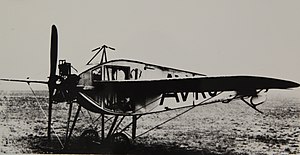Avro Type F
| Type F | |
|---|---|
 |
|
| Role | Experimental aircraft |
| Manufacturer | A.V.Roe and Company |
| First flight | 1 May 1912 |
| Number built | 1 |
The Avro Type F was an early single seat British aircraft from Avro. On 1 May 1912 it became the first aircraft in the world to fly with a completely enclosed cabin for the pilot as an integral part of the design.
It was a wire-braced mid-wing monoplane with a tailskid undercarriage. The fuselage was teardrop-shaped with flat sides with cellon windows. Oil leakage from the engine had been anticipated to obscure pilot view by coating cabin windows; so two circular windows at the pilot's head level could be opened for the pilot's head to protrude when flying, but their use proved unnecessary. Ingress and egress was via a sheet-aluminum trapdoor in the fuselage top. The cabin was quite cramped, being only 2 ft (60 cm) across at its widest point.
The Type F made a few test flights in mid-1912 until damaged beyond repair in a hard landing on 13 September, after which it was not repaired. Its Viale 35 hp engine is on display at the Science Museum in London; and the rudder was preserved by the Royal Aero Club.
Data from
General characteristics
Performance
...
Wikipedia
